Table of contents
- Driving report Vyrus Australian Arrow 749 RS Arrow of the south
- Allen Vyrus with Ducati V two-cylinder
- Technical specifications
- The Vyrus company
- Vyrus Australian Arrow 749 RS

Piper
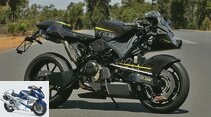
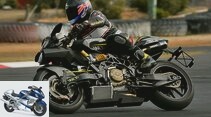
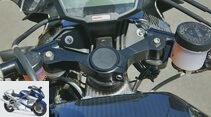
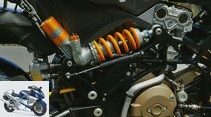
7th pictures
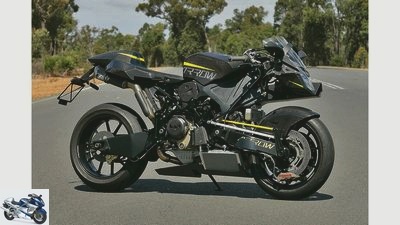
Piper
1/7
Vyrus Australian Arrow 749 RS with wheel hub steering.
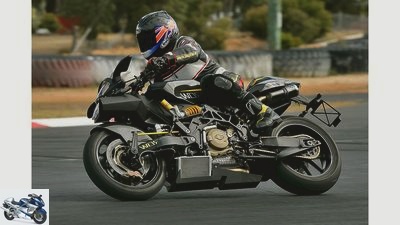
Piper
2/7
The wheel-hub steered Vyrus drives a lot less unusual than it looks.
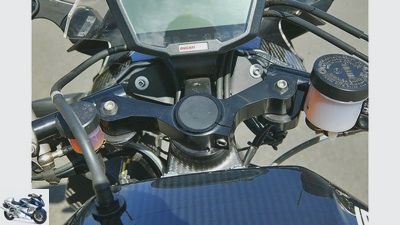
Piper
3/7
The upper triple clamp ends in nothing, but at least gives the handlebar stubs support.
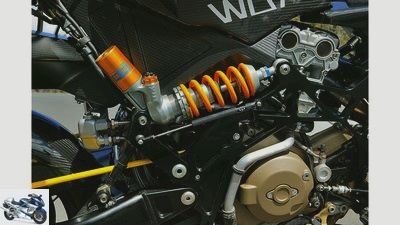
Piper
4/7
The noble front Ohlins shock absorber is acted upon by equally noble kinematics.

Piper
5/7
Switch like a rally KTM. Where is the road book?
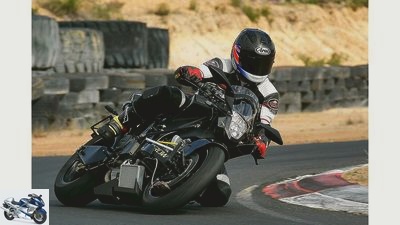
Piper
6/7
By separating the steering and suspension, the Vyrus can be braked deep into the curve.
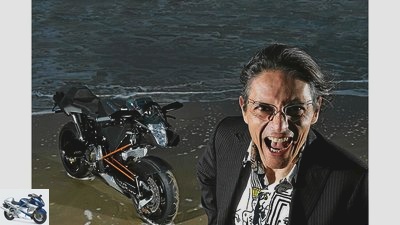
Piper
7/7
Ascanio Rodorigo (founder of the Vyrus company) is sometimes shrill, sometimes quiet – but wheel hub steering must always be.
motorcycles
Driving report Vyrus Australian Arrow 749 RS
Driving report Vyrus Australian Arrow 749 RS
Arrow of the south
Bimota first went into series production: in 1991 the small manufacturer launched the Tesi with wheel hub steering. The Italian Ascanio Rodorigo has been indulging in this technique since 2003. His Vyrus models are popular with tech-savvy people in homeopathic numbers.
Stefan Gluck, Alan Cathcart
03/15/2013
Exactly 146 copies were made from the beginning of the Vyrus period until today, i.e. fewer than 15 motorcycles per year. This is why the small manufactory, which, like Bimota, is based in Rimini, can cater to the needs of the individual customer in detail. So it is that there are no two identical Vyrus there and each one has its own name. The example presented here is called the Australian Arrow and belongs – surprise! – an Australian. Exactly – he said Neil Allison, a mechanical engineer from Perth. Among the rare ones, his Vyrus is something special. But more on that later.
Buy complete article
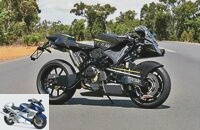
Driving report Vyrus Australian Arrow 749 RS
Arrow of the south
4 pages) as PDF
€ 2.00
Buy now
Allen Vyrus with Ducati V two-cylinder
What all Vyrus have in common, in addition to being powered by a Ducati V twin-cylinder, is the pushed front swing arm with the steering integrated into the front wheel hub, which is controlled by a complex and ingenious system of tension and compression struts. The purpose of the exercise is to separate steering and suspension, which, at least in theory, promises advantages over the usual telescopic fork. In practice, however, the early Tesi by Bimota, for example, often suffered from poor straight-line stability, combined with poor feedback from the forehand. The high costs due to the complex mechanics and the unusual design have prevented market success so far.
With extensive modifications, these deficiencies in the Vyrus should now be a thing of the past and the theoretical advantages of the system should come into play, says company boss Ascanio Rodorigo. Whether you like the Vyrus is in the eye of the beholder, it is always an eye-catcher. It just seems to be made of three materials: aluminum, titanium and loads of carbon fiber. It looks like a mixture of insect and alien.
In addition, the Vyrus has a number of advantages: This machine weighs just 153 kilograms when ready to drive without petrol. That is a whopping 30 kilograms less than the motor donor, a Ducati 749 R, weighs in. This brings us to what makes the Australian arrow really unique: Because all siblings were previously powered by the larger engines from the 999 or 1098.
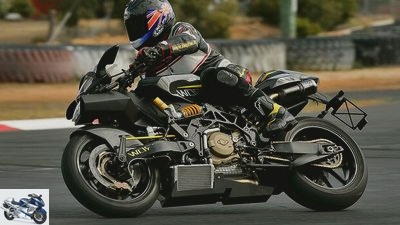
Piper
The wheel-hub steered Vyrus drives a lot less unusual than it looks.
However, the engine of the Australian Arrow is a very special one: It comes from the factory 749 RS on which Lorenzo Lanzi took part in the 2004 Supersport World Championship and ended up in fifth place. The best results were four fourth places. You don’t come across such a unit by chance, but since Rodorigo was Lanzi’s personal mechanic from 2000, the distances to the Ducati factory were short, and so he was able to buy the factory bike without further ado after the end of the 2004 season. Rodorigo actually wanted to use it to power his own Vyrus, but Neil Allison insisted on a small engine.
And after no other aggregate could be found, he got the factory engine. He explains this stubbornness with the fact that a certain Alan Cathcart said in a report that for racers with a driving ability on this side of the then -Ducati factory driver Troy Bayliss, the smaller engine was the more sociable. And it is precisely this Alan Cathcart who is now allowed to run the Australian Arrow on the small, winding race track of Collie near Perth.
Although the Vyrus has lights, indicators and a horn, it also cuts a fine figure on the racetrack. In addition to full midrange power from 7000 revs, the factory engine shows an enthusiastic revving pleasure and hellish revving power. From 10,300 rpm the twin literally begins to explode, from 13,200 tours the first lights on the original 749 dashboard start to flash. And if you don’t use the very easy and precise gearbox up to 13,800 revolutions, the limiter turns off the current to protect the engine from self-destruction. The fully load-bearing motor only develops minimal vibrations. Despite the revised mapping, the throttle response is quite hard in the lower speed range, but for jagged progress on the track there should always be more than 9000 revolutions.
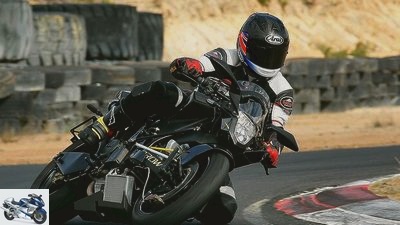
Piper
By separating the steering and suspension, the Vyrus can be braked deep into the curve.
The only really annoying thing is the clutch, which calls for bear strength and pumps up the left arm within a very short time. Although almost without a fairing, the Vyrus offers a touch of wind protection, because the strange-looking bracket above the headlight effectively guides the air flow over the helmet. The three carbon fiber brake discs in connection with the chassis are also very effective. After a few rounds of getting used to it, you trust the system and move the braking points further and further back. Even if you think you have long since passed the point of no return, a courageous grip reaches into the iron and the load follows the desired line. It’s unbelievable how far you can brake into the curve with the Vyrus because the chassis geometry does not change. The separation of steering and damping comes into its own here. To find out the real limit of the construction, several more laps would be required. In addition to the chassis geometry of a 250cc racer (see data box), the balanced weight distribution of 50/50 percent with the driver is responsible for the good driving characteristics. The enormous handiness does not come at the price of weaknesses in straight-line stability, nor is kickback an issue, even without a steering damper.
In the end, the realization remains that the Ackermann steering is basically not the wrong way to go. But to be successful, it needs loving attention from experts like Rodorigo, who strengthen its advantages and eradicate its weaknesses.
Technical specifications
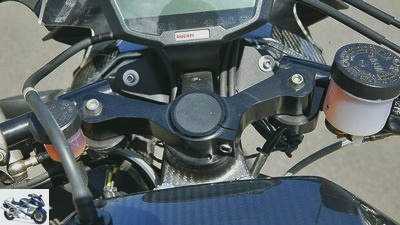
Piper
The upper triple clamp ends in nothing, but at least gives the handlebar stubs support.
engine
Water-cooled two-cylinder four-stroke 90 degree V2 engine, two overhead, toothed belt-driven camshafts, four valves, desmodromic, wet sump lubrication, injection, Ø 54 mm, multi-plate dry clutch, six-speed gearbox, O-ring chain.
Bore x stroke 94.0 x 54.0 mm
Displacement 749 cm3
Rated output 101 kW (137 hp) at 13,000 rpm
Maximum torque k. A..
landing gear
Subframe made of aluminum and carbon fiber, supporting the engine, pushed swing arm at the front; Wheel hub steering, adjustable spring base, rebound and compression damping, steering damper, two-arm swing arm with aluminum beams, central spring strut with lever system, adjustable spring base, rebound and compression damping, front double disc brake, Ø 320 mm, four-piston fixed calipers, rear disc brake, Ø 210 mm, direct central spring strut hinged.
Cast aluminum wheels 3.5 x 17; 5.5 x 17
Tires 120/75 ZR 17; 180/55 ZR 17
Tires tested by Pirelli Diabolo Supercorsa
Dimensions + weights
Wheelbase 1385 mm, steering head angle 72.0 degrees, caster 96 mm, spring travel v / h k. A., seat height k. A., weight ready to drive without petrol 153 kg, tank capacity 14.5 liters.
Price ready to drive from 27,000 euros
<!– ESI FOR ads.BannerGallery / irelements / esielement / eyJwYWdlIjoiL3N0YXJ0c2VpdGUvIiwibGF5b3V0IjoiYXJ0aWNsZSIsImVsZW1lbnQiOiJhZHMuQmFubmVyR2FsbGVyeSIsImlyQ29uZmlnIjoiMTQ3MTU4MTMiLCJwYXJhbXMiOnt9LCJpc01vYmlsZSI6ZmFsc2V9 –> <!– CACHEABLE –>&# 34;,&# 34; rectangle&# 34 ;: “<!–# include virtual = \&# 34 / irelements / esielement / eyJwYWdlIjoiL3N0YXJ0c2VpdGUvIiwibGF5b3V0IjoiYXJ0aWNsZSIsImVsZW1lbnQiOiJhZHMuUmVjdGFuZ2xlR2FsbGVyeSIsImlyQ29uZmlnIjoiMTQ3MTU4MTMiLCJwYXJhbXMiOnt9LCJpc01vYmlsZSI6ZmFsc2V9 \&# 34; –> <!– ESI FOR ads.RectangleGallery / irelements / esielement / eyJwYWdlIjoiL3N0YXJ0c2VpdGUvIiwibGF5b3V0IjoiYXJ0aWNsZSIsImVsZW1lbnQiOiJhZHMuUmVjdGFuZ2xlR2FsbGVyeSIsImlyQ29uZmlnIjoiMTQ3MTU4MTMiLCJwYXJhbXMiOnt9LCJpc01vYmlsZSI6ZmFsc2V9 –> <!– CACHEABLE –>&# 34;,&# 34; sky&# 34 ;: “<!–# include virtual = \&# 34 / irelements / esielement / eyJwYWdlIjoiL3N0YXJ0c2VpdGUvIiwibGF5b3V0IjoiYXJ0aWNsZSIsImVsZW1lbnQiOiJhZHMuU2t5R2FsbGVyeSIsImlyQ29uZmlnIjoiMTQ3MTU4MTMiLCJwYXJhbXMiOnt9LCJpc01vYmlsZSI6ZmFsc2V9 \&# 34; –> <!– ESI FOR ads.SkyGallery / irelements / esielement / eyJwYWdlIjoiL3N0YXJ0c2VpdGUvIiwibGF5b3V0IjoiYXJ0aWNsZSIsImVsZW1lbnQiOiJhZHMuU2t5R2FsbGVyeSIsImlyQ29uZmlnIjoiMTQ3MTU4MTMiLCJwYXJhbXMiOnt9LCJpc01vYmlsZSI6ZmFsc2V9 –> <!– CACHEABLE –>&# 34;}}” ga-track-vis =”article.gallery.inline.vis” class =”v-A_-article__inline-container”>
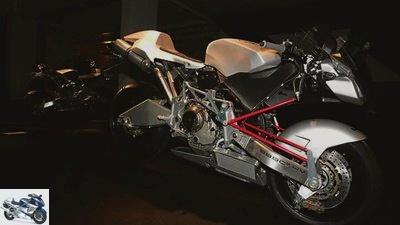
Gori




5 pictures
Pictures: Driving report Vyrus Australian Arrow 749 RS
go to Article
To home page
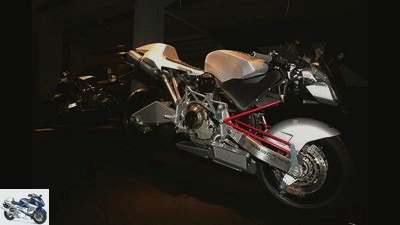
Gori

Gori
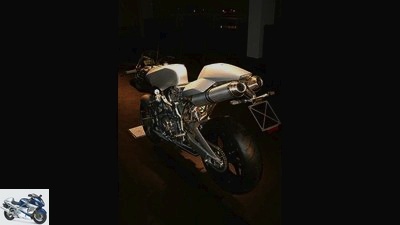
Gori
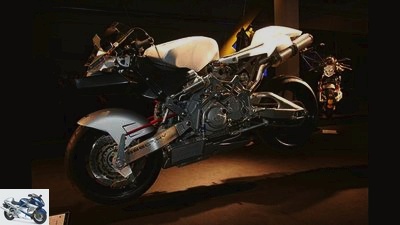
Gori
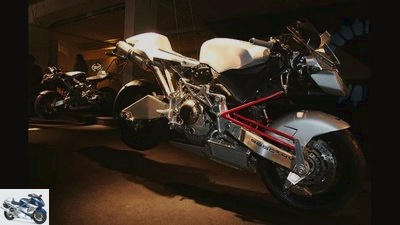
Gori
1/5
The Vyrus company
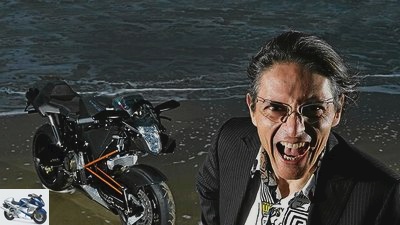
Piper
Ascanio Rodorigo (founder of the Vyrus company) is sometimes shrill, sometimes quiet – but wheel hub steering must always be.
Ascanio Rodorigo (50) was once employed by Bimota, but he left the two-wheeler forge on the Adriatic long before the first knuckle-jointed Tesi was produced there. He quickly got bored of small series production, but he was tremendously interested in the Tesi project. As early as 1985 he had set up his own company in prototype construction with his company APR, and in 2002 he and a handful of employees built a wheel-hub-steered motorcycle for the custom bike show in Padua. Since night shifts were the rule and the motorcycle had long since infected everyone involved, the name Vyrus came up at some point: a brand was born. The first Vyrus was powered by an air-cooled Ducati two-valve engine, and the four-valve Desmos were added later. For race fans there is a Moto2 version with the engine of the Honda CBR 600 RR. Vyrus kits are available from just under 20,000 euros, and ready-to-drive models from 27,000 euros. As is so often the case, there is no upper limit.
Vyrus Australian Arrow 749 RS
Engine: Water-cooled two-cylinder four-stroke 90 degree V2 engine, two overhead, toothed belt-driven camshafts, four valves, desmodromic, wet sump lubrication, injection, Ø 54 mm, multi-plate dry clutch, six-speed gearbox, O-ring chain.
Bore x stroke 94.0 x 54.0 mm
Displacement 749 cc, rated output 101 kW (137 hp) at 13,000 rpm, maximum torque n / a. A..
Landing gear: Subframe made of aluminum and carbon fiber, supporting the engine, pushed swing arm at the front; Wheel hub steering, adjustable spring base, rebound and compression damping, steering damper, two-arm swing arm with aluminum beams, central spring strut with lever system, adjustable spring base, rebound and compression damping, front double disc brake, Ø 320 mm, four-piston fixed calipers, rear disc brake, Ø 210 mm, direct central spring strut hinged.
Cast aluminum wheels 3.5 x 17; 5.5 x 17
Tires 120/75 ZR 17; 180/55 ZR 17
Tires tested: Pirelli Diabolo Supercorsa
Dimensions + weights: Wheelbase 1385 mm, steering head angle 72.0 degrees, caster 96 mm, spring travel v / h k. A., seat height k. A., weight ready to drive without petrol 153 kg, tank capacity 14.5 liters, price ready to drive from 27,000 euros.
Related articles
-
Driving report Brough Superior S.P. 100
Kyoichi Nakamura motorcycles Driving report Brough Superior S.P. 100 Driving report Brough Superior S.P. 100 Rebirth A legend has resurrected: the famous…
-
motorcycles Driving report Touratech Oryx Driving report Touratech Oryx The crony Soon oryx will also be sighted in Europe. This is less about the…
-
Driving report Suzuki GSX-R 600 (2008)
Suzuki motorcycles Super athlete Driving report Suzuki GSX-R 600 (2008) Driving report Suzuki GSX-R 600 (2008) Gixxer with a new swing The new GSX-R 600…
-
Ducati Multistrada 1200 S in the driving report
Photo: Ducati 34 pictures Ducati 1/34 Ducati Multistrada 1200 S.. Ducati 2/34 Ducati Multistrada 1200 S.. Ducati 3/34 Ducati Multistrada 1200 S.. Ducati…
-
Driving report Ducati Streetfighter S
Ducati 7th pictures Ducati 1/7 Ducati Streetfighter / S Ducati 2/7 Ducati Streetfighter / S Ducati 3/7 Ducati Streetfighter / S Ducati 4/7 Ducati…
-
Driving report: Honda CBF 1000 F
Rudolph 10 pictures Rudolph 1/10 Even when the going is steep uphill, the CBF 1000 F pulls on without ceasing. Rudolph 2/10 Now adjustable: the spring…
-
Driving report Ducati Multistrada 1000 S
motorcycles Driving report Ducati Multistrada 1000 S Driving report Ducati Multistrada 1000 S Gold pen Ralf Schneider 08/03/2005 Slowly but surely the…
-
Exclusive driving report BMW K 1200 S
fact motorcycles Tourer Exclusive driving report BMW K 1200 S Exclusive driving report BMW K 1200 S Dare to do sport BMW relies on sport. But not just…
-
Ducati V4 R (2019) in the driving report
Motorcycle fair in Milan EICMA 2021 Presented by Photo: Ducati 31 pictures Ducati 1/31 We were already able to drive the new Ducati V4 R in Jerez. Ducati…
-
Photos: Markus Jahn motorcycles Driving report Honda CBF 1000 Driving report Honda CBF 1000 The candidate Germany has been waiting for him. Honda’s new…